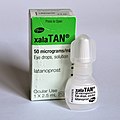Latanoprost
Latanoprost is a medication primarily used in the treatment of ocular hypertension and open-angle glaucoma, conditions that can lead to vision loss if not properly managed. It is classified as a prostaglandin analogue, which works by increasing the outflow of aqueous humor from the eye, thereby reducing intraocular pressure (IOP). Latanoprost is administered as eye drops.
Mechanism of Action
Latanoprost is a prodrug that is activated through hydrolysis to its acid form, latanoprost acid, after topical application to the eye. The active form of latanoprost acts on the prostaglandin F receptor (FP receptor), increasing the outflow of aqueous humor through the uveoscleral pathway, which in turn reduces intraocular pressure. The reduction of IOP is crucial in preventing optic nerve damage and preserving vision in patients with glaucoma or ocular hypertension.
Pharmacokinetics
After topical application, latanoprost is absorbed through the cornea where it is converted to its active form. Peak concentrations in the aqueous humor are reached about two hours after administration. The systemic absorption of latanoprost is low, and it is primarily metabolized in the liver. The elimination half-life of latanoprost is approximately 17 hours, and it is excreted mainly through the kidneys.
Clinical Use
Latanoprost is indicated for the reduction of elevated intraocular pressure in patients with open-angle glaucoma or ocular hypertension. It is often prescribed when other treatments, such as beta-blockers, are not effective or are contraindicated. Latanoprost is typically administered once daily in the evening, which has been shown to be the most effective regimen for reducing IOP.
Side Effects
The most common side effects of latanoprost include conjunctival hyperemia, eye irritation, and changes in eyelash growth. It may also cause a gradual change in the color of the eyes by increasing the amount of brown pigment in the iris. This change may be permanent, especially with long-term use. Less common side effects include blurred vision, eye pain, and the development of a cystoid macular edema.
Comparisons with Other Treatments
Latanoprost has been compared to other IOP-lowering medications, such as timolol, a beta-blocker, and has been found to be equally or more effective in reducing intraocular pressure. Its once-daily dosing and relatively mild side-effect profile make it a preferred choice for many patients.
Formulations and Brands
Latanoprost is available under various brand names, including Xalatan, among others. It is also available in combination with other medications, such as timolol, in products designed to provide an additive effect in lowering IOP.
Transform your life with W8MD's budget GLP-1 injections from $125.
W8MD offers a medical weight loss program to lose weight in Philadelphia. Our physician-supervised medical weight loss provides:
- Most insurances accepted or discounted self-pay rates. We will obtain insurance prior authorizations if needed.
- Generic GLP1 weight loss injections from $125 for the starting dose.
- Also offer prescription weight loss medications including Phentermine, Qsymia, Diethylpropion, Contrave etc.
NYC weight loss doctor appointments
Start your NYC weight loss journey today at our NYC medical weight loss and Philadelphia medical weight loss clinics.
- Call 718-946-5500 to lose weight in NYC or for medical weight loss in Philadelphia 215-676-2334.
- Tags:NYC medical weight loss, Philadelphia lose weight Zepbound NYC, Budget GLP1 weight loss injections, Wegovy Philadelphia, Wegovy NYC, Philadelphia medical weight loss, Brookly weight loss and Wegovy NYC
|
WikiMD's Wellness Encyclopedia |
| Let Food Be Thy Medicine Medicine Thy Food - Hippocrates |
Medical Disclaimer: WikiMD is not a substitute for professional medical advice. The information on WikiMD is provided as an information resource only, may be incorrect, outdated or misleading, and is not to be used or relied on for any diagnostic or treatment purposes. Please consult your health care provider before making any healthcare decisions or for guidance about a specific medical condition. WikiMD expressly disclaims responsibility, and shall have no liability, for any damages, loss, injury, or liability whatsoever suffered as a result of your reliance on the information contained in this site. By visiting this site you agree to the foregoing terms and conditions, which may from time to time be changed or supplemented by WikiMD. If you do not agree to the foregoing terms and conditions, you should not enter or use this site. See full disclaimer.
Credits:Most images are courtesy of Wikimedia commons, and templates, categories Wikipedia, licensed under CC BY SA or similar.
Translate this page: - East Asian
中文,
日本,
한국어,
South Asian
हिन्दी,
தமிழ்,
తెలుగు,
Urdu,
ಕನ್ನಡ,
Southeast Asian
Indonesian,
Vietnamese,
Thai,
မြန်မာဘာသာ,
বাংলা
European
español,
Deutsch,
français,
Greek,
português do Brasil,
polski,
română,
русский,
Nederlands,
norsk,
svenska,
suomi,
Italian
Middle Eastern & African
عربى,
Turkish,
Persian,
Hebrew,
Afrikaans,
isiZulu,
Kiswahili,
Other
Bulgarian,
Hungarian,
Czech,
Swedish,
മലയാളം,
मराठी,
ਪੰਜਾਬੀ,
ગુજરાતી,
Portuguese,
Ukrainian
Contributors: Prab R. Tumpati, MD


